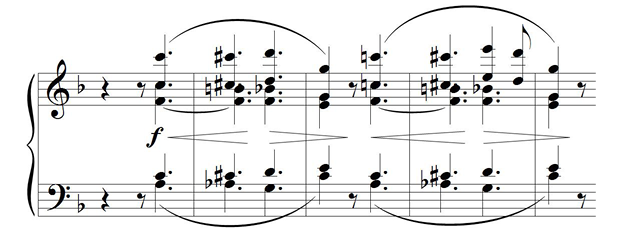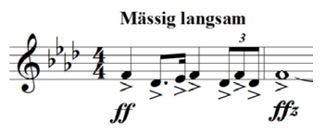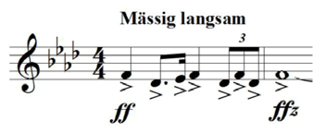Eugen d’Albert
(b. Glasgow, April 10, 1864 - d. Riga, March 3, 1932)
Symphony in F major, op. 4
Preface
Eugen d’Albert’s first nominal effort in the realm of the symphony, at least that is still extant, is not the piece that would become his opus 4. It is an unfinished torso of a work in D minor, begun late in 1878 when d’Albert was fourteen years old. The title page reads:
Seinem Freunde Max Pauer gewidmet
Symphony I in D minor
for full orchestra
composed and arranged for four hands
by Eugene F.C. d’Albert
This holograph manuscript source,1 which is held at the Library of Congress in Washington, DC along with the full score manuscript of the F-major Symphony,2 suggests that an orchestral version of a D-minor symphony may have existed. There is some evidence that the four-hands version of the piece was the original, however, and that d’Albert intended to orchestrate it later. The first movement is an Allegro vivace with an inscribed completion date of Friday, December 27, 1878. The Poco Adagio second movement was completed on February 21, 1879. The third, intended to be a scherzo marked Presto, has a false start in C minor; d’Albert then restarted the movement in B-flat (following an attacca G-minor chord), before trailing off with no conclusion.
Dedicated to one of his formative teachers, Max Pauer, this unknown work demonstrates the teenaged d’Albert’s early interest in composing for the orchestra, in theory if not yet in practice. In a sense d’Albert’s career trajectory followed that of another of his mentors, Franz Liszt: best known at first as a virtuoso pianist, he later developed a focus on his compositional work; in d’Albert’s case the calling was opera, but he also composed a number of piano works, concerti, and Lieder in addition to his operatic contributions, especially in the early stages of his compositional career.
D’Albert referenced in a letter to his parents on March 15, 1882 that he had shown some of his symphony to Brahms,3 who had taken an interest in the precocious musician. It is usually assumed that d’Albert showed Brahms excerpts from the F-major Symphony, but the date of the correspondence suggests that it may have been an earlier work shown to Brahms—perhaps even a portion of the D-minor symphony mentioned above.
The holograph manuscript for the full score of the Symphony in F major, opus 4 has a receipt-date stamp of March 30, 1886 by the firm of Ed. Bote & G. Bock. D’Albert dated the completion of each movement in the manuscript:
I. Mässig bewegt [Coburg. 18 Juni 1885]
II. Langsam, aber nicht schleppend [Coburg. 14 Juli 1885]
III. Sehr schnell [Coburg. 13 August 1885]
IV. Mässig langsam [Coburg. 15 October 1885]
On the final page of the manuscript is a brief sketch for an unrelated “Klavierstuck 4.” The orchestral manuscript’s title page does not indicate a dedication, but in the published score the symphony was dedicated to the pianist and composer Karl Klindworth (1830-1916; Klindworth was noted for his piano reductions of the Ring cycle, among other compositional and pedagogical accomplishments). The four-hand version offered by Ed. Bote & G. Bock was not arranged by d’Albert, who of course was perfectly capable of such a task. Instead, it was prepared by Robert Keller (1828-1891), an arranger best known for his piano adaptations of the music of Brahms, giving some indication of the expectations of success for the work.
By the time d’Albert completed his symphony at the age of 21, he had composed many works that remained unpublished. But preceding works that he had seen through publication included his opus 1 suite for piano, the B-minor opus 2 piano concerto, and a set of ten Lieder as his opus 3. While the piano concerto drew on Lisztian sonorities and structure, d’Albert’s symphonic debut owed more to the music of Brahms. While d’Albert’s symphony was accepted for publication in 1886, the composer would not have the opportunity to really experience the piece until working with Hans von Bülow and the Berlin Philharmonic in January of 1892, when they prepared the work for performances in Berlin and Hamburg.4 D’Albert apparently took Bülow’s suggestions to heart, editing the work under Bülow’s constructive critique, and Bülow in turn also grew from the experience.5 While the work would not become part of the “canon,” it nonetheless represented an important step in d’Albert’s development as a composer. His efforts in the symphonic realm served d’Albert well as he continued writing instrumental music, and by the time he moved into the world of opera he was able to write adeptly for the orchestra.
The trouble with obscure works is that there is an assumption that they must have been neglected for some reason of deficiency. When approached with an open mind and a sense of the odds against any given piece staying in the repertoire, d’Albert’s symphony provides a window into the development of a talented young composer. D’Albert had the good fortune to have positive relationships with both Liszt and Brahms, and the good sense to realize that he could learn much of value from each. The influence of Brahms is felt particularly keenly in d’Albert’s symphony. Beyond the pursuit of a Brahmsian sound in the orchestration and the thoughtful development of the material, the shadow of Brahms’ first symphony falls across the score without overwhelming the music. D’Albert’s material is genuinely interesting and beautifully scored, and one could do worse than to draw on Brahms as a model. One example of the nature of this relationship is to be found in the treatment of thematically-related material across movements; d’Albert’s use is more akin to the thematic developmental references across movements found in Brahms’ first symphony than the cyclical references of the third.6
Consider the rising chromatic line in the opening of Brahms’ first symphony, and its use near the close of the second movement. D’Albert integrated a similar but lighter thematic and affective gesture throughout his symphony, quite naturally and cleverly. A few samples of this recurring idea will suffice:
Example 1
D’Albert, Symphony in F, op. 4, I: 15 mm. before F—11 mm. before F; extracted winds
D’Albert, Symphony in F, op. 4, III: 1 m. before B—8 mm. after B; cl., bn. & strings
D’Albert, Symphony in F, op. 4, IV: 20 mm. after P—24 mm. after P; reduction
Other instances of these relationships are to be found among similar and differing materials throughout the symphony, indicating the tautness of construction, perhaps assisted by the swift speed of the symphony’s composition.
D’Albert’s symphony has had its detractors, but Bülow’s advocacy should be enough to give one pause. The first movement’s themes are compelling and well worked out, and the movement is a convincing opener; the second movement is mysterious with moments of stunning beauty; the main musical material of the scherzo is finely and humorously wrought; and the finale aspires to the ideals of the closing movement of Brahms first symphony while winking at Wagner and Liszt. Think of the dramatic manner in which Brahms introduces what will become the melodic focus of the first symphony’s finale. We find that d’Albert structures the drama along the same lines; what starts as a slow, forceful horn statement eventually becomes the “big tune” of the finale:
Example 2
D’Albert, Symphony in F, op. 4, IV: mm. 1-2; horns
D’Albert, Symphony in F, op. 4, IV: 17 mm. after B—24 mm. after B; strings
It is with great energy and optimism that d’Albert ends his sole surviving contribution to the symphonic genre; it is hoped that the strengths of the work can be appreciated alongside its role in the development of this talented composer, and that it will be afforded opportunities for audiences to hear it. Several recordings have been released in the past few years, which bodes well for d’Albert’s prospects.
David Plylar, 2017
1 D’Albert, Eugen, “Symphony I, in D minor, for full orchestra, composed & arr. for four hands,” in the Heineman Foundation Collection of the Library of Congress: ML31 .H43a no. 23.
2 D’Albert, Eugen, “Symphonie F dur, für grosses Orchester, op. 4,” in the Heineman Foundation Collection of the Library of Congress: ML31 .H43a no. 24 Case.
3 Quoted in Pangels, Charlotte, Eugen d’Albert, Wunderpianist und Komponist (Zurich: Atlantis Musikbuch-Verlag, 1981), 31.
4 Ibid., 122.
5 Ibid., 122-3. It is not known to this author if those revisions have survived.
6 When d’Albert finished the composition of his symphony on October 15, 1885, Brahms fourth symphony had not yet been premiered, and Tchaikovsky had only completed four of his symphonies.
For performance material please contact Bote und Bock, Berlin.
-------------------------------------------
Eugen d’Albert
(geb. Glasgow, 10. April 1864 – gest. Riga, 3. März 1932)
Sinfonie F-Dur op. 4
Vorwort
Eugen d’Alberts erster nennenswerter Erfolg auf dem Gebiet der Sinfonie, der noch erhalten ist, ist nicht das Stück, welches sein Opus 4 wurde. Es ist der unvollendete Torso eines Werkes in d-Moll, den d’Albert spät im Jahr 1878 im Alter von 14 Jahren begann. Die Titelseite lautete:
Seinem Freunde Max Pauer gewidmet
Symphonie I in d - Moll
für grosses Orchester
komponiert und arrangiert für vier Hände
von Eugene F.C. d’Albert
Die handschriftliche Quelle1, die zusammen mit dem Manuskript der Partitur der F-Dur-Symphonie2 in der Library of Congress in Washington D.C. liegt, deutet an, dass eine Orchesterfassung einer d-Moll-Symphonie existiert haben könnte. Es gibt Anzeichen, dass die vierhändige Fassung des Stückes original ist und d’Albert sie später orchestrieren wollte. Der erste Satz ist ein Allegro vivace und wurde Freitag, den 27. Dezember 1878 vollendet, der zweite Satz Poco Adagio am 21. Februar 1879. Der dritte sollte ein Scherzo sein – und ist als Presto bezeichnet –, er beginnt mit einem „Fehlstart“ in c-Moll; d’Albert begann den Satz erneut in B (gefolgt von einem attaca g-Moll-Akkord), ehe er ohne Schluss allmählich verstummt.
Dieses unbekannte Stück ist Max Pauer gewidmet, einem seiner prägendsten Lehrer, und demonstriert das frühe Interesse des jungen d’Albert an Orchesterkompositionen – in der Theorie, wenn auch nicht in der Praxis. In einem gewissen Sinn folgt der Verlauf von d’Alberts Karriere dem eines seiner anderen Mentoren: Franz Liszt, der zunächst als Klaviervirtuose bekannt wurde und später erst den Fokus auf sein kompositorisches Werk legte. In d’Alberts Fall war es der Ruf der Oper; zudem komponierte er u.a. in der Frühphase seiner Komponistenlaufbahn eine Vielzahl von Klavierwerken, Konzerten und Liedern zusätzlich zu seinen Bühnenwerken.
D’Albert wies in einem Brief an seine Eltern vom 15. März 1882 darauf hin, dass er einiges von seiner Symphonie Brahms gezeigt habe3, der Interesse an dem talentierten Musiker hatte. Es ist anzunehmen, dass d’Albert Brahms Ausschnitte der F-Dur-Symphonie vorlegte, jedoch lässt das Datum der Korrespondenz vermuten, dass es sich möglicherweise um ein früheres Werk handelte – vielleicht eben ein Teil der oben erwähnten d-Moll-Symphonie.
Das handschriftliche Manuskript der Partitur der F-Dur-Symphonie op. 4 ist laut Quittung vom 30. März 1886 beim Verleger Bote & G. Bock angekommen. D’Albert notierte die Fertigstellung jedes Satzes im Manuskript:
I. Mässig bewegt [Coburg, 18. Juni 1885]
II. Langsam, aber nicht schleppend [Coburg, 14. Juli 1885]
III. Sehr schnell [Coburg, 13. August 1885]
IV. Mässig langsam [Coburg, 15. October 1885]
Auf der letzten Seite des Manuskripts befindet sich eine kurze Skizze eines nicht verwandten „Klavierstück 4“. Die Titelseite des Partitur-Manuskripts nennt keine Widmung, die veröffentlichte Partitur ist dem Pianisten und Komponisten Karl Klindworth (1830-1916; Klindworth wurde für seine Klavierauszüge des Rings sowie weitere kompositorische und pädagogische Leistungen geachtet) gewidmet. Die vierhändige Fassung, die von Bote & G. Bock angeboten wurde, stammte nicht von d’Albert, der natürlich für eine solche Aufgabe prädestiniert gewesen wäre. Stattdessen wurde sie von Robert Keller (1828-1891) erstellt, der für seine Klavieradaptionen der Musik von Brahms bekannt war und damit einen Hinweis auf die Erfolgsaussichten der Arbeit gibt.
Als d’Albert seine Sinfonie im Alter von 21 Jahren vollendete, hatte er bereits zahlreiche Werke komponiert, die unveröffentlicht geblieben sind. Unter den vorangegangenen Werken, die durch Veröffentlichung überlebt haben, sind die Suite für Klavier op. 1, das Klavierkonzert h-Moll op. 2 sowie die Lieder op. 3. Während sich das Klavierkonzert klanglich und strukturell auf Liszt bezieht, erinnert d’Alberts sinfonisches Debut eher an die Musik von Brahms. Da d’Alberts Sinfonie 1886 zur Publikation angenommen wurde, hatte der Komponist bis zur Zusammenarbeit mit Hans von Bülow und den Berliner Philharmonikern im Januar 1892 – sie erarbeiteten das Werk für Aufführungen in Berlin und Hamburg4 – nicht die Möglichkeit, die Komposition wirklich zu erleben. Offensichtlich nahm sich d’Albert von Bülows Anregungen zu Herzen, redigierte das Werk unter dessen konstruktiver Kritik und lernte daraus.5 Obwohl das Stück nicht in den „Kanon“ aufgenommen wurde, repräsentiert es trotzdem eine wichtige Phase in d’Alberts Entwicklung als Komponist. Seine Anstrengungen auf sinfonischem Gebiet kamen ihm beim weiteren Komponieren von Instrumentalmusik zugute, und als er sich in die Welt der Oper begab, war er des geschickten Orchestrierens mächtig.
Die Schwierigkeit mit unbekannten Werken ist, dass man gemeinhin annimmt, dass sie aufgrund irgendwelcher Unzulänglichkeiten vernachlässigt wurden. Wenn man d’Alberts Symphonie jedoch mit Unbefangenheit und einem Sinn für Chancengleichheit entgegentritt, bietet sie einen Einblick in die Entwicklung eines talentierten jungen Komponisten. D’Albert hatte das Glück, gute Beziehungen zu Liszt und Brahms zu pflegen, und war klug genug, von ihnen zu lernen. Brahms’ Einfluss ist besonders stark in seiner Symphonie zu spüren. Jenseits des Strebens nach brahms’schem Orchesterklang und der sorgfältigen Entwicklung des Materials liegt der Schatten von Brahms’ erster Symphonie über der Partitur, ohne die Musik zu erdrücken. D’Alberts Material ist wirklich interessant und schön gesetzt, und man könnte nichts Schlimmeres tun, als sich Brahms zum Vergleich zu nehmen. Ein Beispiel für den Charakter dieser musikalischen Beziehung findet sich in der Behandlung von thematisch verwandtem Material durch die Sätze hindurch; d’Alberts Herangehensweise ist der Entwicklung des thematischen Materials, wie sie Brahms innerhalb seiner ersten Symphonie angeht, ähnlicher als den zyklischen Aspekten seiner dritten.6
Man beachte die aufsteigende chromatische Linie zu Beginn von Brahms’ erster Symphonie und deren Verwendung gegen Ende des zweiten Satzes. D’Albert baut eine ähnliche, jedoch leichtere und affektbetontere Geste in seine Symphonie ein, völlig natürlich und pfiffig. Einige Beispiele dieser wiederkehrenden Idee sollen reichen:
Beispiel 1
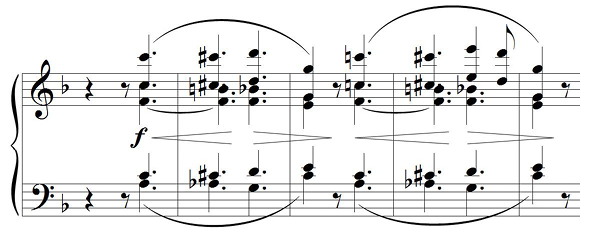
D’Albert, Sinfonie in F op. 4, I: 15 Takte vor F bis 11 Takte vor F; Bläser

D’Albert, Sinfonie in F op. 4, III: ein Takt vor B bis 8 Takte nach B; Klarinette, Fagott und Streicher
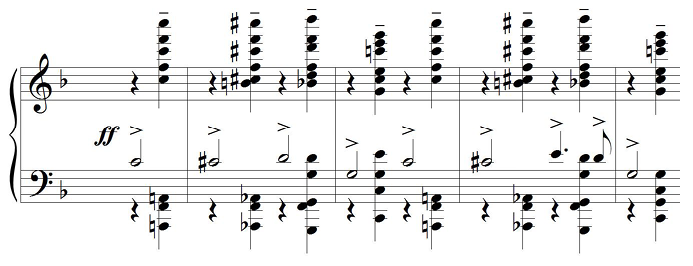
D’Albert, Sinfonie in F op. 4, IV: 20 Takte nach P bis 24 Takte nach P; Auszug
Weitere Belegstellen dieser Beziehungen sind in ähnlichem und auch unterschiedlichem Material innerhalb der Sinfonie zu finden und weisen auf die Straffheit der Dramaturgie hin – vielleicht unterstützt durch die Kürze der Kompositionszeit.
D’Alberts Symphonie hatte ihre Kritiker, jedoch sollte von Bülows Fürsprache genug zu denken geben. Die Themen des ersten Satzes sind fesselnd und gut ausgearbeitet; der Satz eröffnet das Werk in überzeugender Weise. Der zweite Satz ist geheimnisvoll und gespickt mit Momenten von atemberaubender Schönheit. Das musikalische Hauptmaterial des Scherzo ist fein und humorvoll gefertigt, und das Finale strebt zu den Idealen des letzten Satzes von Brahms’ erster Symphonie, während es Wagner und Liszt zuzwinkert. Man denke an die dramatische Art, in der Brahms sein Material vorstellt, das dann der melodische Fokus des Finales seiner ersten Symphonie werden soll. Wir sehen, dass d’Alberts „Dramaturgie“ analog verläuft; was als langsame, kraftvolle Hornmelodie beginnt, wird schließlich der „große Wurf“ des Finales:
Beispiel 2
D’Albert, Sinfonie in F op. 4, IV: Takte 1-2; Hörner

D’Albert, Sinfonie in F op. 4, IV: 17 Takte nach B bis 24 Takte nach B; Streicher
Mit enormer Energie und Optimismus beendet d’Albert seinen einzigen überlieferten Beitrag zum Genre der Symphonie. Es ist zu hoffen, dass die Stärken des Werkes neben dessen Rolle in der Entwicklung des talentierten Komponisten gewürdigt werden, und dass es Möglichkeiten zum Hören des Werkes geben wird. Dazu sind mehrere Einspielungen in den letzten Jahren erschienen, - gute Aussichten also für d’Alberts Symphonie.
Übersetzung: Anke Westermann
1 D’Albert, Eugen: Symphony I, in D minor, for full orchestra, composed & arr. for four hands, in: Heineman Foundation Collection, Library of Congress: ML 31. H43a no. 23.
2 D’Albert, Eugen: Symphonie F-dur, für grosses Orchester, op. 4, in: Heineman Foundation Collection, Library of Congress: ML 31. H43a no. 24 Case.
3 zitiert nach: Pangels, Charlotte: Eugen d’Albert. Wunderpianist und Komponist. Zürich: Atlantis 1981, 31.
4 Ibid., 122.
5 Ibid., 122-123. Es ist dem Autor nicht bekannt, ob diese Revisionen überliefert sind.
6 Als d’Albert seine Symphonie am 15. Oktober 1885 vollendete, war Brahms vierte Symphonie noch nicht uraufgeführt und Tschaikowsky hatte erst vier seiner Symphonie vollendet.
Aufführungsmaterial ist von Bote und Bock, Berlin, zu beziehen.


